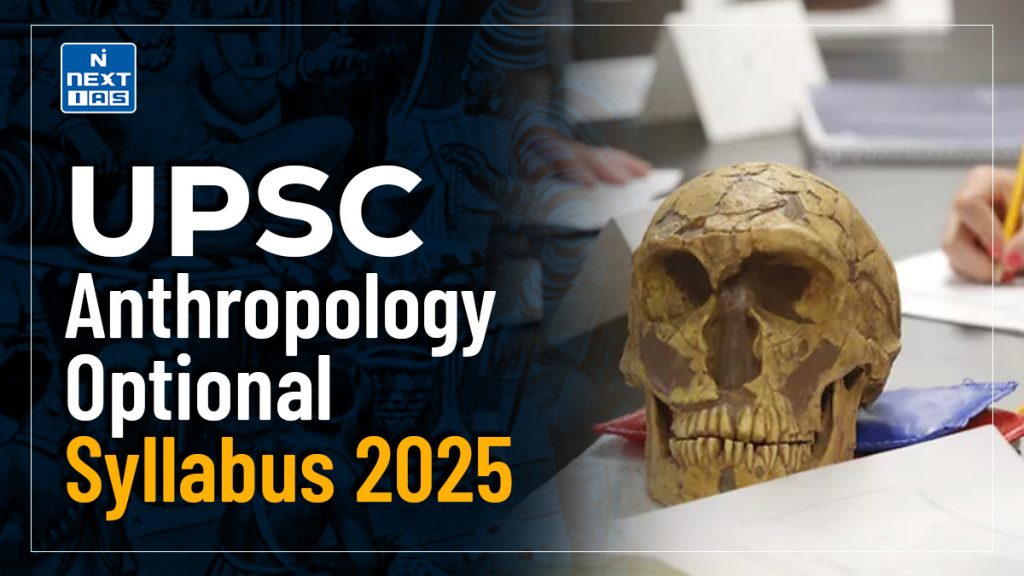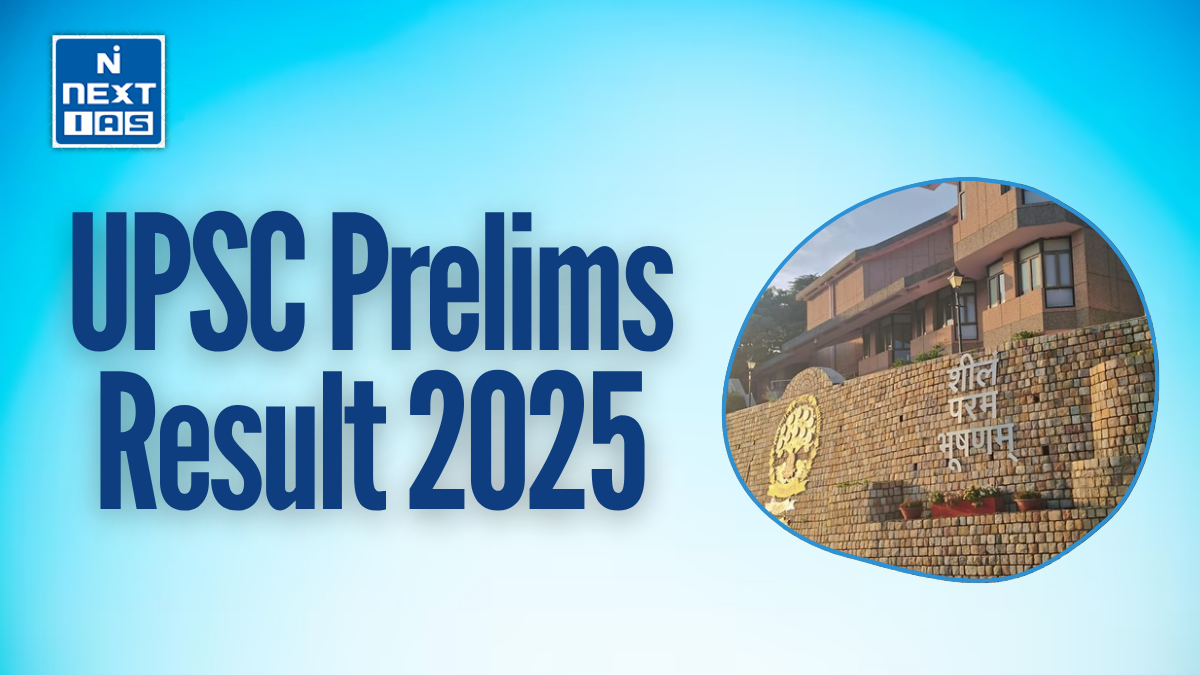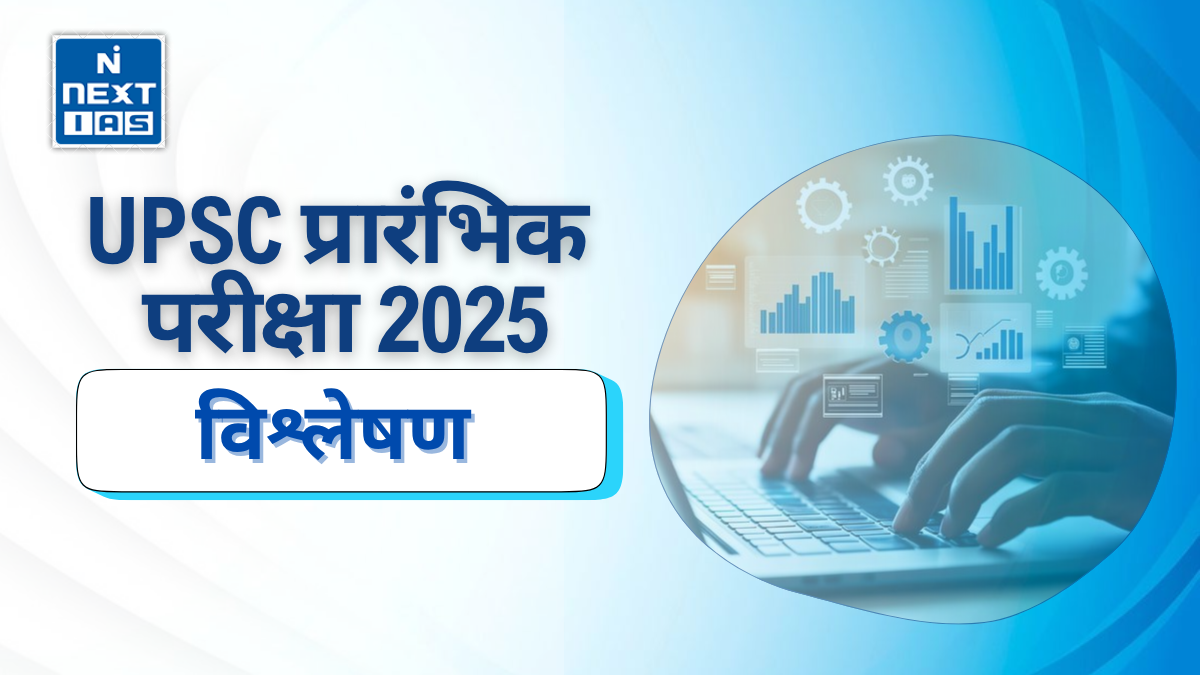
The Anthropology Optional subject for UPSC Civil Services Examination is a popular choice among aspirants from various academic backgrounds, including science, engineering, and humanities. Its structured and analytical approach, combined with a clear theoretical framework, makes it an attractive option for those aiming for high scores. This article aims to study in detail the UPSC Anthropology Optional syllabus, effective preparation strategies, and provide insights into the biological, cultural, and social aspects of anthropology.
About Anthropology Optional Syllabus
- The UPSC Anthropology Syllabus for Paper 1 covers fundamental topics such as the biological aspects of anthropology, including human evolution, genetics, and primates, as well as cultural anthropology, which covers human societies, their structures, and cultural evolution.
- This paper provides a comprehensive foundation in the scientific study of humans, focusing on both biological and cultural dimensions.
- The UPSC Anthropology Syllabus for Paper 2 shifts to Indian anthropology, concentrating on the tribal population, social structure, and the impact of cultural diversity and modernization on India’s social systems.
- It also covers Indian social problems, including poverty, inequality, and rural development.
UPSC Anthropology Optional Syllabus for Paper 1
The UPSC Anthropology Optional Syllabus for Paper 1 is primarily conceptual and theoretical, offering a solid foundation for scoring well. However, the subject’s technical aspects, such as understanding human evolution, genetics, and the relationship between biological and cultural anthropology, require dedicated effort and focused preparation.
PAPER 1 Syllabus
1.1 Meaning, Scope and development of Anthropology.
1.2 Relationships with other disciplines: Social Sciences, behavioural Sciences, Life Sciences, Medical Sciences, Earth Sciences and Humanities.
1.3 Main branches of Anthropology, their scope and relevance:
- Social-cultural Anthropology.
- biological Anthropology.
- Archaeological Anthropology.
- Linguistic Anthropology.
1.4 Human Evolution and emergence of Man:
- Biological and Cultural factors in human evolution.
- Theories of Organic Evolution (Pre-Darwinian, Darwinian and Post-Darwinian).
- Synthetic theory of evolution; Brief outline of terms and concepts of evolutionary biology (Doll’s rule, Cope’s rule, Gause’s rule, parallelism, convergence, adaptive radiation, and mosaic evolution).
1.5 Characteristics of Primates; Evolutionary Trend and Primate Taxonomy; Primate Adaptations; (Arboreal and Terrestrial) Primate Taxonomy; Primate Behaviour; Tertiary and Quaternary fossil primates; Living Major Primates; Comparative Anatomy of Man and Apes; Skeletal changes due to erect posture and its implications.
1.6 Phylogenetic status, characteristics and geographical distribution of the following:
- Plio-preleistocene hominids inSouth and East Africa – Australopithecines.
- Homo erectus: Africa (Paranthropus), Europe (Homo erectus (heidelbergensis), Asia (Homo erectus javanicus, Homo erectus pekinensis.
- Neanderthal man-La-chapelle-aux-saints (Classical type), Mt. Carmel (Progressive type).
- Rhodesian man.
- Homo sapiens-Cromagnon, Grimaldi and Chancelede.
1.7 The biological basis of Life: The Cell, DNA structure and replication, Protein Synthesis, Gene, Mutation, Chromosomes, and Cell Division.
1.8 (a) Principles of Prehistoric Archaeology. Chronology: Relative and Absolute Dating methods.
(b) Cultural Evolution-Broad Outlines of Prehistoric cultures:
- Paleolithic
- Mesolithic
- Neolithic
- Chalcolithic
- Copper-Bronze age
- Iron Age
2.1 The Nature of Culture: The concept and Characteristics of culture and civilization; Ethnocentrism vis-a-vis cultural Relativism.
2.2 The Nature of Society: Concept of Society; Society and Culture; Social Institution; Social groups; and Social stratification.
2.3 Marriage: Definition and universality; Laws of marriage (endogamy, exogamy, hypergamy, hypogamy, incest taboo); Type of marriage (monogamy, polygamy, polyandry, group marriage). Functions of marriage; Marriage regulations (preferential, prescriptive and proscriptive); Marriage payments (bride wealth and dowry).
2.4 Family: Definition and universality, Family, household and domestic groups; functions of family; Types of family (from the perspectives of structure, blood relation, marriage, residence and succession); Impact of urbanization, industrialization and feminist movements on family
2.5 Kinship: Consanguinity and Affinity; Principles and types of descent (Unilineal, Double, Bilateral Ambilineal); Forms of descent groups (lineage, clan, phratry, moiety and kindred); Kinship terminology (descriptive and classificatory); Descent, Filiation and Complimentary Filiation; Decent and Alliance.
3. Economic Organization: Meaning, scope and relevance of economic anthropology; Formalist and Substantivist debate; Principles governing production, distribution and exchange (reciprocity, redistribution and market), in communities, subsisting on hunting and gathering, fishing, swiddening, pastoralism, horticulture, and agriculture; globalization and indigenous economic systems.
4. Political Organization and Social Control: Band, tribe, chiefdom, kingdom and state; concepts of power, authority and legitimacy; social control, law and justice in simple Societies.
5. Religion: Anthropological approaches to the study of religion (evolutionary, psychological and functional); monotheism and polytheism; sacred and profane; myths and rituals; forms of religion in tribal and peasant Societies (animism, animatism, fetishism, naturism and totemism); religion, magic and science distinguished; magico-religious functionaries (priest, shaman, medicine man, sorcerer and witch).
6. Anthropological theories:
- Classical evolutionism (Tylor, Morgan and Frazer)
- Historical particularism (Boas) Diffusionism (British, German and American)
- Functionalism (Malinowski); Structural-Functionlism (Radcliffe-Brown)
- Structuralism (L’evi-Strauss and E. Leach)
- Culture and personality (Benedict, Mead, Linton, Kardiner and Cora-du Bois)
- Neo-evolutionism (Childe, White, Steward, Sahlins and Service)
- Cultural materialism (Harris)
- Symbolic and interpretive theories (Turner, Schneider and Geertz)
- Cognitive theories (Tyler, Conklin)
- Post-modernism in anthropology.
7. Culture, Language and Communication: Nature, origin and characteristics of language; verbal and non-verbal communication; social contex of language use.
8. Research methods in Anthropology:
- Fieldwork tradition in anthropology
- Distinction between technique, method and methodology
- Tools of data collection: observation, interview, schedules, questionnaire, case study, genealogy, life-history, oral history, secondary sources of information, participatory methods.
- Analysis, interpretation and presentation of data.
9.1 Human Genetics: Methods and Application: Methods for study of genetic principles in man-family study (pedigree analysis, twin study, foster child, co-twin method, cytogenetic method, chromosomal and karyo-type analysis), biochemical methods, immunological methods, D.N.A. technology and recombinant
technologies.
9.2 Mendelian genetics in man-family study, single factor, multifactor, lethal, sub-lethal and polygenic inheritance in man.
9.3 Concept of genetic polymorphism and selection, Mendelian population, Hardy-Weinberg law; causes and changes which bring down frequency-mutation, isolation, migration, selection, inbreeding and genetic drift. Consanguineous and non-consanguineous mating, genetic load, genetic effect of consanguineous and cousin marriages.
9.4 Chromosomes and chromosomal aberrations in man, methodology.
- Numerical and structural aberrations (disorders).
- Sex chromosomal aberration- Klinefelter (XXY), Turner (XO), Super female (XXX), intersex and other syndromic disorders.
- Autosomal aberrations- Down syndrome, Patau, Edward and Cri-du-chat syndromes.
- Genetic imprints in human disease, genetic screening, genetic counseling, human DNA profiling, gene mapping and genome study.
9.5 Race and racism, biological basis of morphological variation of non-metric and characters. Racial criteria, racial traits in relation to heredity and environment; biological basis of racial classification, racial differentiation and race crossing in man.
9.6 Age, sex and population variation as genetic marker: ABO, Rh blood groups, HLA Hp, transferring, Gm, blood enzymes. Physiological characteristics-Hb level, body fat, pulse rate, respiratory functions and sensory perceptions in different cultural and socio-ecomomic groups.
9.7 Concepts and methods of Ecological Anthropology: Bio-cultural Adaptations—Genetic and Nongenetic factors. Man’s physiological responses to environmental stresses: hot desert, cold, high altitude climate.
9.8 Epidemiological Anthropology: Health and disease. Infectious and non-infectious diseases, Nutritional deficiency related diseases.
10. Concept of human growth and Development: Stages of growth—pre-natal, natal, infant, childhood, adolescence, maturity, senescence.
- Factors affecting growth and development genetic, environmental, biochemical, nutritional, cultural and socio-economic.
- Ageing and senescence. Theories and observations biological and chronological longevity. Human physique and somatotypes. Methodologies for growth studies.
11.1 Relevance of menarche, menopause and other bioevents to fertility. Fertility patterns and differentials.
11.2 Demographic theories-biological, social and cultural.
11.3 Biological and socio-ecological factors influencing fecundity, fertility, natality and mortality.
12. Applications of Anthropology: Anthropology of sports, Nutritional anthropology, Anthroplogy in designing of defence and other equipments, Forensic Anthroplogy, Methods and principles of personal identification and reconstruction, Applied human genetics—Paternity diagnosis, genetic counselling and eugenics, DNA technology in diseases and medicine, serogenetics and cytogenetics in reproductive biology.
UPSC Anthropology Optional Syllabus for Paper 2
The UPSC Anthropology Optional Syllabus for Paper 2 focuses on Indian Anthropology, covering both the cultural and social aspects of Indian society. It includes topics such as tribal communities, social structure, family systems, and the role of anthropology in understanding India’s diversity.
PAPER 2 Syllabus
1.1 Evolution of the Indian Culture and Civilization: Prehistoric (Palaeolithic, Mesolithic, Neolithic and Neolithic-Chalcolithic), Protohistoric (Indus Civilization). Pre-Harappan, Harappan and postHarappan cultures. Contributions of the tribal cultures to Indian civilization.
1.2 Palaeo: Anthropological evidences from India with special reference to Siwaliks and Narmada basin (Ramapithecus, Sivapithecus and Narmada Man)
1.3. Ethno-archaeology in India: The concept of ethno-archaeology; Survivals and Parallels among the hunting, foraging, fishing, pastoral and peasant communities including arts and crafts producing communities.
2. Demographic profile of India: Ethnic and linguistic elements in the Indian population and their distribution. Indian population—factors influencing its structure and growth.
3.1 The structure and nature of traditional Indian social system: Varnashram, Purushartha, Karma, Rina and Rebirth.
3.2 Caste system in India: Structure and characteristics Varna and caste, Theories of origin of caste system, Dominant caste, Caste mobility, Future of caste system, Jajmani system. Tribe-case continuum.
3.3 Sacred Complex and Nature: Man-Spirit Complex.
3.4 Impact of Buddhism, Jainism, Islam and Christianity of Indian society.
4. Emergence, growth and development in India: Contributions of the 18th, 19th and early 20th Century scholar-administrators. Contributions of Indian anthropologists to tribal and caste studies.
5.1 Indian Village: Significance of village study in India; Indian village as a social system; Traditional and changing patterns of settlement and inter-caste relations; Agrarian relations in Indian villages; Impact of globalization on Indian villages.
5.2 Linguistic and religious minorities and their social, political and economic status.
5.3 Indigenous and exogenous processes of socio-cultural change in Indian society: Sanskritization, Westernization, Modernization; Inter-play of little and great traditions; Panchayati Raj and social change; Media and Social change.
6.1 Tribal situation in India: Bio-genetic variability, linguistic and socio-economic characteristics of the tribal populations and their distribution.
6.2 Problems of the tribal Communities: Land alienation, poverty, indebtedness, low literacy, poor educational facilities, unemployment, under- employment, health and nutrition.
6.3 Developmental projects and their impact on tribal displacement and problems of rehabilitation. Development of forest policy and tribals. Impact of urbanisation and industrialization on tribal populations.
7.1 Problems of exploitation and deprivation of Scheduled Castes, Scheduled Tribes and Other Backward Classes. Constitutional safeguards for Scheduled Tribes and Scheduled Castes.
7.2 Social change and contemporary tribal societies: Impact of modern democratic institutions, development programmes and welfare measures on tribals and weaker sections.
7.3 The concept of ethnicity: Ethnic conflicts and political developments; Unrest among tribal communities; Regionalism and demand for autonomy; Pseudotribalism. Social change among the tribes during colonial and post Independent India.
8.1 Impact of Hinduism, Buddhism, Christianity, Islam and other religions on tribal societies.
8.2 Tribe and nation state: a comparative study of tribal communities in India and other countries.
9.1 History of administration of tribal areas, tribal policies, plans, programmes of tribal development and their implementation. The concept of PTGs (Primitive Tribal Groups), their distribution, special programmes for their development. Role of N.G.O.s in tribal development.
9.2 Role of anthropology in tribal and rural development.
9.3 Contributions of anthropology to the understanding of regionalism, communalism and ethnic and political movements.
Download UPSC Anthropology Optional Syllabus PDF
Our team has compiled the complete UPSC Anthropology Optional Syllabus in a detailed and easy-to-read PDF format. Click the link below to download the UPSC Anthropology Optional Syllabus PDF.
UPSC Anthropology Optional Exam Pattern
| UPSC Anthropology Optional Paper 1 | 250 Marks |
| UPSC Anthropology Optional Paper 2 | 250 Marks |
| UPSC Anthropology Optional Duration | 3 Hours Each |
UPSC Anthropology Optional Syllabus 2025 Preparation Strategy
To prepare effectively for the UPSC Anthropology Optional Syllabus, the following points need to be noted:
- Understand the Syllabus: To begin by thoroughly understanding the syllabus and analysing previous years’ question papers to identify important topics and patterns in the exam.
- Build a Strong Foundation: To start with the basics, such as human evolution, sociocultural anthropology, and anthropological theories.
- Utilize NCERTs: To focus on chapters from NCERT Biology and Sociology that form the base for anthropology concepts.
- Select Appropriate Study Material: To refer to standard textbooks such as Physical Anthropology by P. Nath and Indian Anthropology by Nadeem Hasnain for an in-depth understanding.
- Solve Previous Year’s Papers: To solve at least the past 10-15 years’ UPSC Anthropology question papers to familiarise yourself with the question trends and identify topic weightage.
- Practice Diagrams and Case Studies: To draw diagrams and label them is an essential skill for Anthropology. Practice neat sketches to explain concepts.
- Stay Updated on Current Affairs: Regularly read Anthropology-related news from various sources to stay updated with the latest developments in the field, such as issues relating to tribal welfare and anthropological research.
| Related Courses & Test Series |
| Anthropology Optional Foundation Course |
| Anthropology Optional Advance Course |
| Anthropology Optional Test Series |
In conclusion, the UPSC Anthropology Optional subject offers a distinctive blend of theoretical insights and real-world applications, making it valuable not only for the examination but also for understanding the cultural, social, and evolutionary aspects of human societies. With consistent effort, a clear grasp of anthropological concepts, and the ability to apply these concepts to contemporary issues, aspirants can use this subject to achieve high scores and develop a holistic understanding of human evolution, society, and culture.
| Other Useful Links |
| UPSC CSE Notification 2025: Important Updates and FAQs |
| UPSC Syllabus 2025 |
| UPSC CSAT Syllabus 2025 |
| UPSC CSE Posts |
| All India Services |
| Group A Civil Services |
| Group B Civil Services |
Frequently Asked Questions (FAQs)
Is Anthropology a good optional for UPSC?
Yes, Anthropology is a good optional for UPSC, especially for aspirants with an interest in human evolution, culture, and tribal studies. Its concise syllabus, scientific approach, and scoring potential make it a popular choice.
Is Anthropology optional scoring in UPSC?
Yes, Anthropology is considered a scoring optional. With well-structured answers, effective use of diagrams, case studies, and conceptual clarity, aspirants can achieve high marks in this subject.






